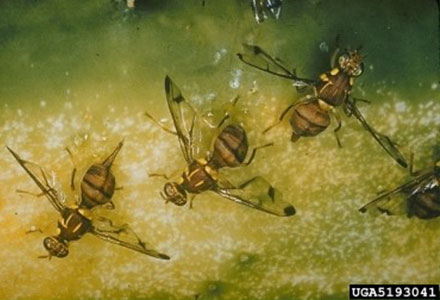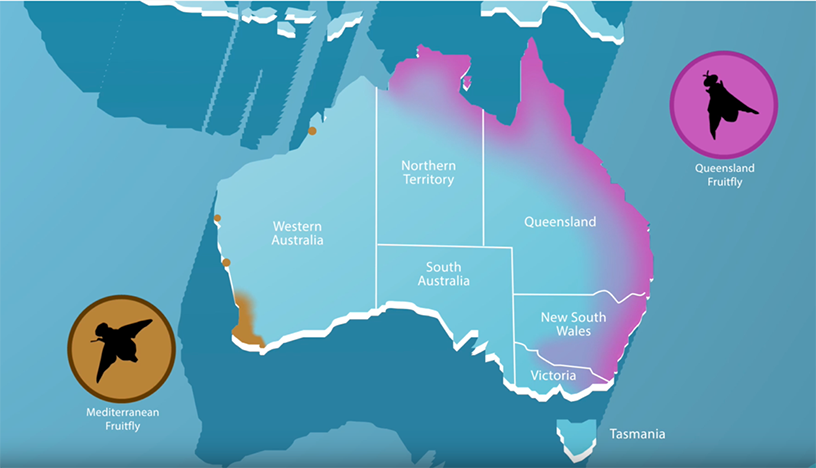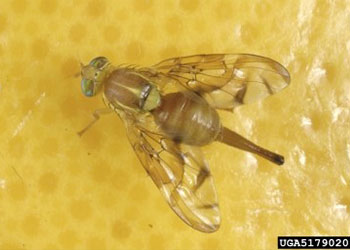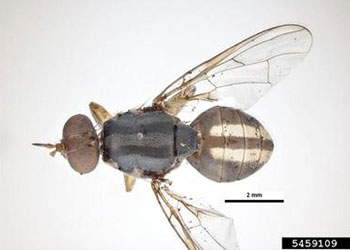PLANT PEST

Florida Division of Plant Industry, Florida Department of Agriculture and Consumer Services, Bugwood.org.
Fruit flies (exotic)
Exotic to Australia. Mediterranean fruit fly is established, found only in Western Australia.
Features: : Fruit flies are one of the world’s most destructive horticultural pests and pose risks to most commercial fruit and vegetable crops. They can cause rots and discolouration. Eggs are laid close to the surface inside the fruit with small discoloured patches developing as a result of the stings
Where they're from: Asia, Africa, Europe, Middle East, Pacific Islands and the Americas. Mediterranean fruit fly is found in Western Australia while others are eradicated on a regular basis from islands in Torres Strait
How they spread: Via wind and importation of infested plant material (primarily fruit)
At risk: Berries, citrus, avocado, mango, papaya, passionfruit, melon, olive, summerfruit, lychees, cherries, apples and pears, and grapes
Australian Chief Plant Protection Officer, Dr Gabrielle Vivian-Smith, provides an overview of the risks posed by exotic fruit flies
Download
If you have difficulty accessing these files, visit web accessibility for assistance.
Keep it out
Fruit flies are one of the world’s most destructive horticultural pests and pose risks to most commercial fruit and vegetable crops. They attack some 300 species of fruit and above ground vegetables.
Exotic fruit flies, including the oriental fruit fly (Bactrocera dorsalis), carambola fruit fly (B. caramboloe) and Mexican fruit fly (Anastrepha ludens) are highly invasive species that threaten Australia’s fruit production as well as our ability to export to other countries.
Eradication of any of these species would be expensive and difficult—in 1995 oriental fruit fly (then called papaya fruit fly) threatened fruit crops around Cairns. It was eradicated but at a cost of $33.5 million, in addition to losses to farmers estimated at $100 million owing to additional quarantine treatments and lost trade opportunities.
Exotic fruit flies would make it difficult to grow many kinds of fruit and many of our trading partners would no longer accept our produce to avoid importing the pests as well.
Importing goods
To keep exotic fruit flies out of Australia, never ignore Australia’s strict biosecurity rules.
Import shipments may need to be treated and certified, so before you import, check our Biosecurity Import Conditions system (BICON).
Stop the spread
While there are more than 150 species of native fruit fly in Australia, most of these do not attack commercial crops, with the notable exception of Queensland fruit fly which lives in Eastern Australia.
There are domestic quarantine restrictions in place to prevent the further spread of this native pest. Fruit and vegetables grown in affected areas cannot be sent to other parts of Australia unless they are treated for Queensland fruit fly. Travellers are not allowed to take fruit and vegetables between states and territories.
One exotic species, the Mediterranean fruit fly (Ceratitis capitata) is present in Western Australia and biosecurity measures are in place to prevent it spreading to other parts of the country. Other species, including the melon fly (Zeugodacus cucurbitae) and Z. cucurbitae are found in Torres Strait from time to time and are subject to ongoing eradication efforts.
It is particularly important to prevent Queensland fruit fly and Mediterranean fruit fly from spreading to South Australia and Tasmania, which are fruit fly free.
Travellers within Australia
Abide by interstate quarantine rules to prevent the spread of Queensland fruit fly and Mediterranean fruit fly. Always check before you travel or move interstate.

What to look for
There are native and established fruit flies in Australia which makes it difficult to distinguish exotic fruit flies from those normally around unless you’re an expert. That’s why the Northern Australia Quarantine Strategy has fruit fly monitoring arrangements in operation in the north of the country.
Keep an eye out for any unusual fruit flies.
Key signs are:
- pin pricks in fruit where females lay eggs
- maggots in rotting fruit.


Where to look
Importers
Importation of infested fruit is the most likely way that these exotic fruit flies would make their way to Australia.
Growers and home gardeners
Check your plants frequently for any new pests or unusual symptoms. Look for:
- larvae—tiny white grubs—in undamaged fruit still on the tree
- pin prick sized holes or scars on the fruit surface
- rotting fruit.
These fruit flies have an appetite for a wide range of fruit and vegetables. Crops include:
- citrus
- grape
- apple
- pear
- cherry
- blueberry
- plum
- peach
- avocado
- lychee
- papaya
- passionfruit
- olive
- summerfruit
- mango.
What to do
If you think you’ve found an exotic fruit fly or larvae:
- do not disturb the insect (this may be as simple as closing the doors on a shipping container or sealing the infested fruit in a container)
- take a photo and collect a sample if possible, without disturbing the flies or larvae.
